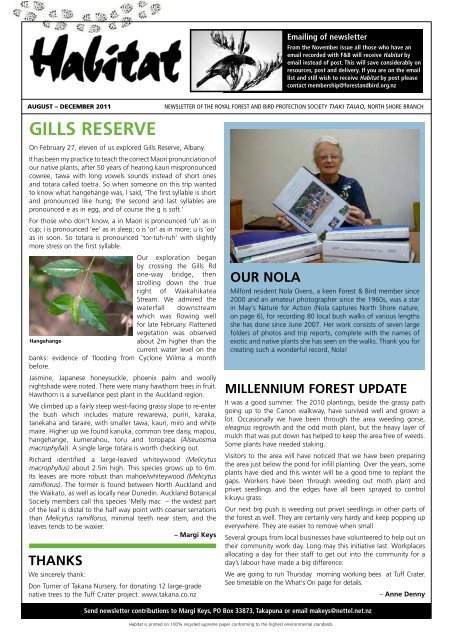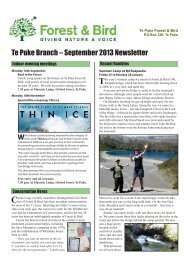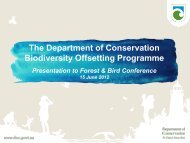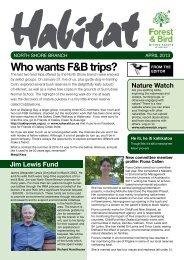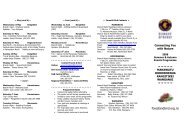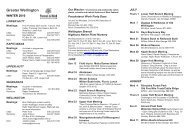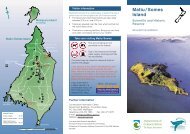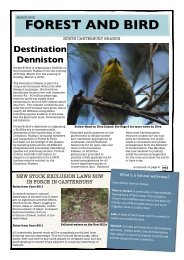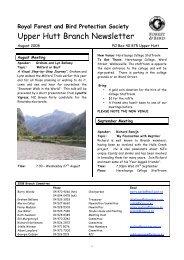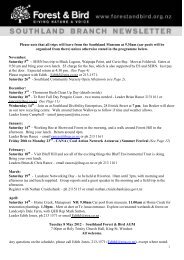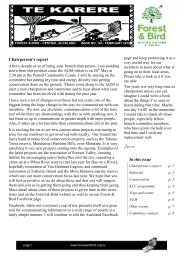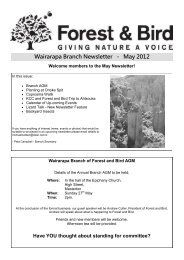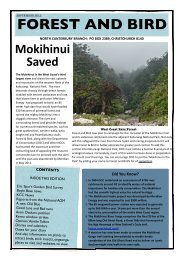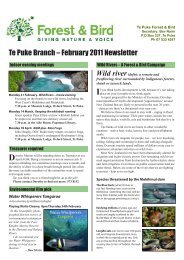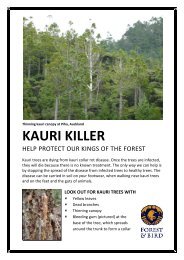gills reserve - Forest and Bird
gills reserve - Forest and Bird
gills reserve - Forest and Bird
Create successful ePaper yourself
Turn your PDF publications into a flip-book with our unique Google optimized e-Paper software.
Emailing of newsletter<br />
From the November issue all those who have an<br />
email recorded with F&B will receive Habitat by<br />
email instead of post. This will save considerably on<br />
resources, post <strong>and</strong> delivery. If you are on the email<br />
list <strong>and</strong> still wish to receive Habitat by post please<br />
contact membership@forest<strong>and</strong>bird.org.nz<br />
AUGUST – DECEMBER 2011 NEWSLETTER OF THE ROYAL FOREST AND BIRD PROTECTION SOCIETY TIAKI TAIAO, NORTH SHORE BRANCH<br />
GILLS RESERVE<br />
On February 27, eleven of us explored Gills Reserve, Albany.<br />
It has been my practice to teach the correct Maori pronunciation of<br />
our native plants, after 50 years of hearing kauri mispronounced<br />
cowree, tawa with long vowels sounds instead of short ones<br />
<strong>and</strong> totara called toetra. So when someone on this trip wanted<br />
to know what hangehange was, I said, ‘The first syllable is short<br />
<strong>and</strong> pronounced like hung; the second <strong>and</strong> last syllables are<br />
pronounced e as in egg, <strong>and</strong> of course the g is soft.’<br />
For those who don’t know, a in Maori is pronounced ‘uh’ as in<br />
cup; i is pronounced ‘ee’ as in sleep; o is ‘or’ as in more; u is ‘oo’<br />
as in soon. So totara is pronounced ‘tor-tuh-ruh’ with slightly<br />
more stress on the first syllable.<br />
Our exploration began<br />
by crossing the Gills Rd<br />
one-way bridge, then<br />
strolling down the true<br />
right of Waikahikatea<br />
Stream. We admired the<br />
waterfall downstream<br />
which was flowing well<br />
for late February. Flattened<br />
vegetation was observed<br />
Hangehange<br />
about 2m higher than the<br />
current water level on the<br />
banks: evidence of flooding from Cyclone Wilma a month<br />
before.<br />
Jasmine, Japanese honeysuckle, phoenix palm <strong>and</strong> woolly<br />
nightshade were noted. There were many hawthorn trees in fruit.<br />
Hawthorn is a surveillance pest plant in the Auckl<strong>and</strong> region.<br />
We climbed up a fairly steep west-facing grassy slope to re-enter<br />
the bush which includes mature rewarewa, puriri, karaka,<br />
tanekaha <strong>and</strong> taraire, with smaller tawa, kauri, miro <strong>and</strong> white<br />
maire. Higher up we found kanuka, common tree daisy, mapou,<br />
hangehange, kumerahou, toru <strong>and</strong> toropapa (Alseuosmia<br />
macrophylla)). A single large totara is worth checking out.<br />
Richard identified a large-leaved whiteywood (Melicytus<br />
macrophyllus) about 2.5m high. This species grows up to 6m.<br />
Its leaves are more robust than mahoe/whiteywood (Melicytus<br />
ramiflorus). The former is found between North Auckl<strong>and</strong> <strong>and</strong><br />
the Waikato, as well as locally near Dunedin. Auckl<strong>and</strong> Botanical<br />
Society members call this species ‘Melly mac – the widest part<br />
of the leaf is distal to the half way point with coarser serrations<br />
than Melicytus ramiflorus, minimal teeth near stem, <strong>and</strong> the<br />
leaves tends to be waxier.<br />
– Margi Keys<br />
THANKS<br />
We sincerely thank:<br />
Don Turner of Takana Nursery, for donating 12 large-grade<br />
native trees to the Tuff Crater project. www.takana.co.nz<br />
OUR NOLA<br />
Milford resident Nola Ovens, a keen <strong>Forest</strong> & <strong>Bird</strong> member since<br />
2000 <strong>and</strong> an amateur photographer since the 1960s, was a star<br />
in May's Nature for Action (Nola captures North Shore nature,<br />
on page 6), for recording 80 local bush walks of various lengths<br />
she has done since June 2007. Her work consists of seven large<br />
folders of photos <strong>and</strong> trip reports, complete with the names of<br />
exotic <strong>and</strong> native plants she has seen on the walks. Thank you for<br />
creating such a wonderful record, Nola!<br />
MILLENNIUM FOREST UPDATE<br />
It was a good summer. The 2010 plantings, beside the grassy path<br />
going up to the Canon walkway, have survived well <strong>and</strong> grown a<br />
lot. Occasionally we have been through the area weeding gorse,<br />
eleagnus regrowth <strong>and</strong> the odd moth plant, but the heavy layer of<br />
mulch that was put down has helped to keep the area free of weeds.<br />
Some plants have needed staking.<br />
Visitors to the area will have noticed that we have been preparing<br />
the area just below the pond for infill planting. Over the years, some<br />
plants have died <strong>and</strong> this winter will be a good time to replant the<br />
gaps. Workers have been through weeding out moth plant <strong>and</strong><br />
privet seedlings <strong>and</strong> the edges have all been sprayed to control<br />
kikuyu grass.<br />
Our next big push is weeding out privet seedlings in other parts of<br />
the forest as well. They are certainly very hardy <strong>and</strong> keep popping up<br />
everywhere. They are easier to remove when small.<br />
Several groups from local businesses have volunteered to help out on<br />
their community work day. Long may this initiative last. Workplaces<br />
allocating a day for their staff to get out into the community for a<br />
day’s labour have made a big difference.<br />
We are going to run Thursday morning working bees at Tuff Crater.<br />
See timetable on the What's On page for details.<br />
– Anne Denny<br />
Send newsletter contributions to Margi Keys, PO Box 33873, Takapuna or email makeys@nettel.net.nz<br />
Habitat is printed on 100% recycled supreme paper conforming to the highest environmental st<strong>and</strong>ards.


